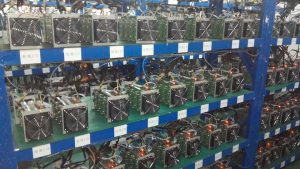
By Jamie Redman
The Institute of Electrical and Electronics Engineering (IEEE) has released a study called “Minting Money With Megawatts,” revealing the fierce competition in the bitcoin mining industry, which is expanding the cryptocurrency network significantly.
The Bitcoin Mining Economy Is Fiercely Competitive
 The report, written by Sveinn Vakfells of Flux Ltd., and Jon Helgi Egilsson from the University of Iceland, details the massive growth of the bitcoin mining enterprise. According to the researchers, miners are consuming 169 MW of power, while pulling in an annual revenue of $545 million.
The report, written by Sveinn Vakfells of Flux Ltd., and Jon Helgi Egilsson from the University of Iceland, details the massive growth of the bitcoin mining enterprise. According to the researchers, miners are consuming 169 MW of power, while pulling in an annual revenue of $545 million.
Bitcoin’s financial network depends on computational mining processes, with revenues being diluted as the system’s processing capacity continues to grow. As growth progresses, miners’ profits subsequently drop, leading to crucial decisions of balancing financial incentives, electric and hardware costs, and the overall performance of mining hardware.
This has led to the author’s belief that incumbent miners will continue to consolidate, while new miners will be pushed out of the industry.
The IEEE report explains:
Capital costs of the latest systems and facilities are high which presents a barrier to entry to new miners. Consolidation in mining raises concerns about the integrity of Bitcoin: the greater the concentration of mining capacity, the greater opportunity the miners have of colluding to attack the blockchain. If any entity or group were to gain control over 51% or more of the mining capacity, they would effectively control the transaction history of the blockchain, and the decentralized, trustless quality of Bitcoin would be destroyed.
After the recent halving, the researchers conclude that new miners are seemingly close to being shut out from the mining economy. Incumbent miners will not be significantly affected as they have already invested capital into existing hardware and facility costs.
However, a spike in price, a rise transaction fees, or if a few early miners fall to the wayside — like with the recent KnC Miner bankruptcy — then opportunities may arise for new miners. But according to the researchers, the barrier entry for new miners will increasingly become difficult in the future.
The IEEE research paper states:
Each future halving of the Bitcoin block reward will narrow the range of profitable entry for new Bitcoin miners considerably. The stronger relative position of incumbents compared to that of new entrants supports further consolidation of Bitcoin mining.
New Processors May Curb Consolidation
 A continuation of mining consolidation could lead to vulnerabilities in the Bitcoin network. The authors say that while Moore’s Law remains valid, new microprocessors have the ability to counteract mining centralization.
A continuation of mining consolidation could lead to vulnerabilities in the Bitcoin network. The authors say that while Moore’s Law remains valid, new microprocessors have the ability to counteract mining centralization.
For instance, Bitmain’s latest mining rig, the Antminer R4 aims to utilize its 16nm Application-Specific Integrated Circuits (ASIC) to bring mining back to the home user. Improvements in ASIC technology and faster chips may keep new miners in the game, but the authors say that newer, emerging technology to follow ASICs will make the industry even more competitive.
The IEEE paper details that the “greatest disruption” to the current bitcoin mining economy will be the rise of technologies such as graphene processors and quantum computers.
D-Wave Quantum Computer
